Wednesday Investigations [2:13]: Andrew CS
Time machines and file hierarchies in Chicago, IL
![Wednesday Investigations [2:13]: Andrew CS](/content/images/size/w1200/2025/04/andrew-cs.jpg)
Although Philadelphia was the first city I ever lived in, and I currently work in Boston, the city that I have the longest relationship with is Chicago. I’ve spent half my life involved with Chicago and the people there, and I am happy to report that these involvements continue to grow richer and deeper, and I return to Chicago whenever I can1. One of the things that drew me to the city in the first place is its fertile, crosspollinated music scene, which I have been fortunate to participate in in various capacities over the years. I’ll spare you the details, but suffice it to say: the vibrant and evolving scene continues to be a source of enduring fascination.
In the past few years I’ve been investigating my way outward from Cached, a record label and “platform for intermedia exploration2” run by another Occasional Chicagoan, Matthew Sage (who began Cached in Chicago, after retiring his previous label, Patient Sounds).
Some of you may know Cached as the label behind the Fuubutsushi collective,3 an ambient / minimalist / post-rock / jazz quartet of consisting of Sage, Chris Jusell, Chaz Prymek, and Patrick Shiroishi, which came together for remote collaboration during the COVID lockdown and became something of a pandemic-era breakout group. But the label has released a wide range of fascinating material; you could begin exploring anywhere in its archive and turn up rewarding gems. They also have an unerring visual aesthetic:
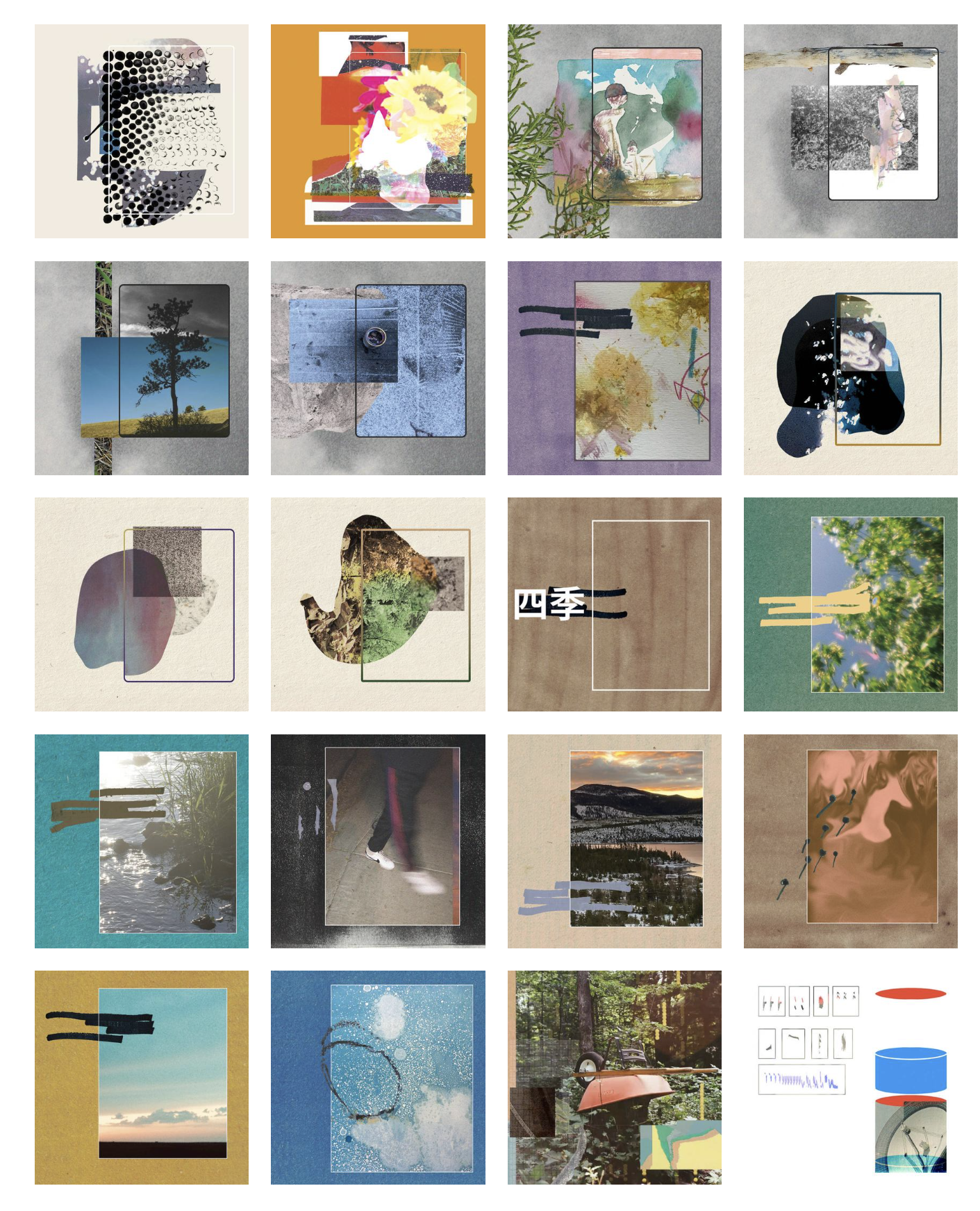
One of the albums up there is nimi, a 2022 collaboration between Chicago artist and musician Andrew CS and the Virginia-based composer Glia. nimi is a fantastic short album, and before too long I worked my way over to *, Andrew’s equally remarkable solo release. I reached out to them with some questions and learned that Andrew’s full-length album, caught in pointers, was about to be released by Leaving Records.
It dropped April 5, and I interviewed Andrew on Monday, April 15.
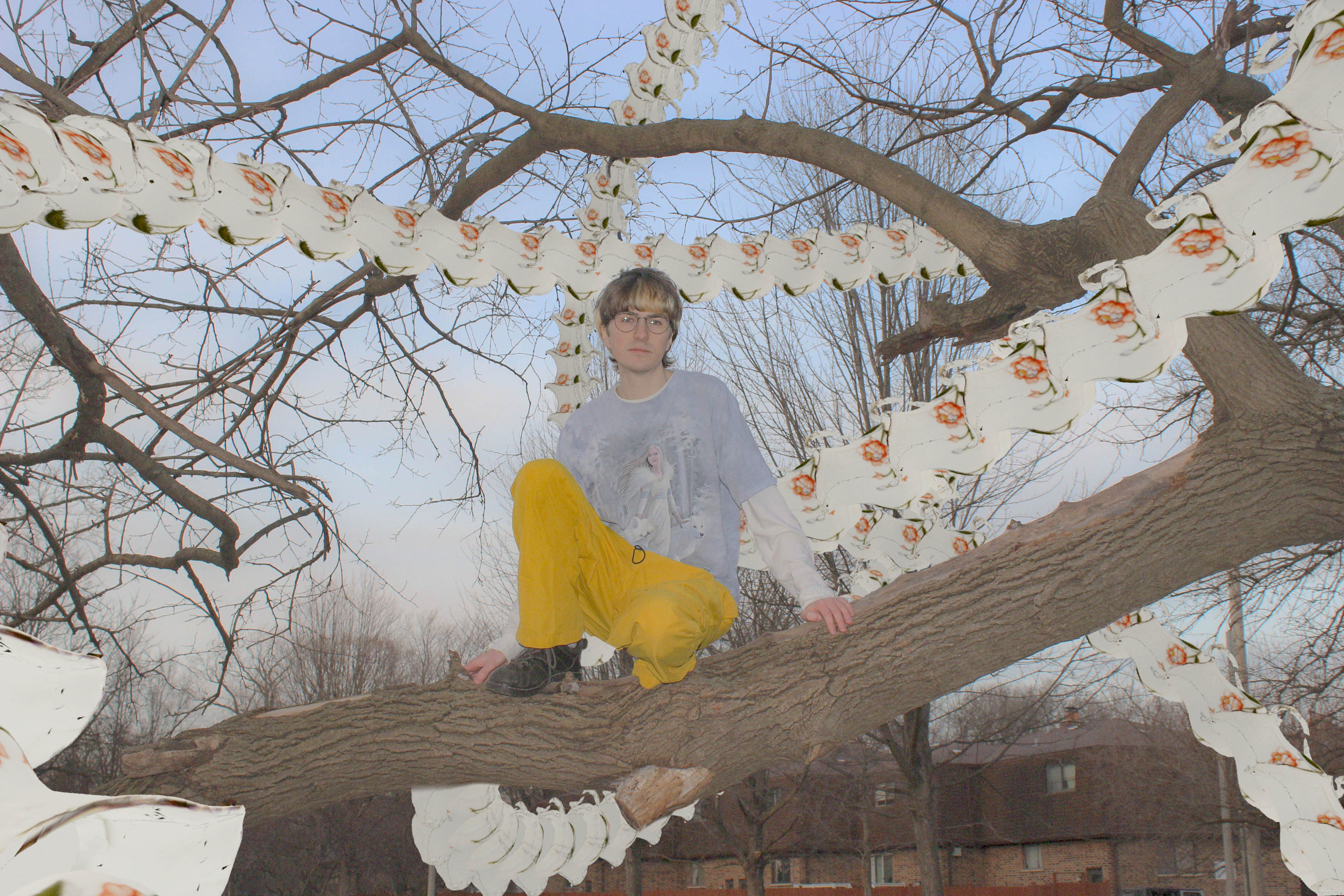
JPB: Congratulations on the new album!
It’s your longest of your recent releases by a significant margin. The albums I have of yours are a sequence of marvelous miniatures: transition spaces (2020) is 17 minutes, * (2021) is 10 minutes, and nimi (2022), your collaboration with Glia, is 22 minutes. caught in pointers, at 52 minutes, is longer than all of them put together. Were you conscious of working on a bigger canvas? Did that change your workflow in any notable way?
ACS: Yea, longer records with lots of songs have been something I've aspired to for a while. I always kind of imagined the first Andrew CS record as having lots of songs.
transistion spaces, *, & nimi were all actually imagined & assembled after I had finished caught in pointers. so the first two were mostly outtakes of songs that I decided not to include in CiP, and Jonathan (Glia) & I put together nimi a little while after.
So I guess the shorter EPs were more just a way to share what I was working on while the record label & I were waiting to be able to share CiP :) Moving forward, I imagine myself focusing on more ambitious projects like that record.
So, if we think of the EPs and the LP as being all part of one big project, then, I want to talk about the themes and concerns of that project.
The idea of “home,” or at least "place," really comes through as central. The liner notes for transition spaces cite “homes and empty rooms” as the album’s theme, or maybe even its source material. “growing up / finding home” is another phrase found in the same notes. The notes for the full album don’t reference home specifically, but they do make it plain that you’re still thinking actively about place and its role in your life—they set the album up as something of a dialogue between the “rural landscapes of [your] youth” and “the oscillations of chicago as an adult.” Do you want to speak, for a moment, to those themes? How much did the thematic material govern the assembly of the releases—like was it foregrounded in your mind as you processed and reworked this audio material?
Yea, there is a narrative arc of something in my own life behind CiP, and the two EPs kind of zoom into little snippets or pieces of that. And as I've hinted at in those same liner notes, I've carried a field recorder everywhere with me since I was a teen, and this music was created around those recordings as a way to convey the feelings that are kind of tied up with each moment.
I'm the kind of person who finds it really easy to forget, especially when there's discomfort or trauma associated with a time or place despite all the beautiful things. So I think art (especially field recording / photography and what comes out of that) is kind of my way of documenting things, having a better understanding of who I was or what I felt at a particular time and doing a better job of holding onto moments of calm or growth. To me that kind of feels like a way to disrupt or redirect the flow of time, by experiencing (fragments of) those moments again there's a way to re-evaluate place-memory and what we experience to be the past.
The hope though is that I'm not just centering my own story — particularly as a white American & descendant of settler colonialism I don't think my life is what the world should be focusing on right now. but the hope is that there are some universal feelings underneath that are hopefully worth sharing.
I think a lot about those issues of colonialism, too, and try to embrace anticolonialist perspectives in my creative work and especially in my teaching. So thanks for bringing that up.
I also am interested in what you're saying about the flow of time. I also think a lot about time, and the flow of time, and what time is “doing.” So my ears prick up when I hear you refer, for instance, to “what we experience to be the past” as opposed to just, simply, “the past.” And I think part of what interested me in your work is the way you talk about the past as a “four-dimensional space” that digital media / digitally-assisted recall allows one to “navigate freely.” You go so far, at times, as to brush up against the idea that your work could serve time capsule or even something akin to a time machine (I'm judging from certain song titles, etc). How did you come to think about it in this way? Did you have an early brush with the idea of the “fourth dimension?” Or has that always just felt like an intuitive way of thinking about it?
This is why music is my favorite medium — it's all about playing with time! And I think it's fun / interesting / inspiring / weird to take ideas like looping and blow them up like a balloon into big metaphors. I've always been hooked on nerdy sci-fi like the movie Interstellar and just the idea that time truly doesn't always flow at the same speed, and even that the linear way that we experience it might be a bit of an awkward perspective trick. So when I started to get into less conventional audio looping and time-based tools it was cool to be able to play with & think about those metaphors.
You have a robust visual art practice, too, and I noticed that earlier you linked field recording with photography.
As a little aside, caught in pointers is both an album and a visual exhibition of some print-focused work, which I'm working on sharing in a couple weeks.
Will that be a digital exhibition, or in a gallery?
Just digital, keeping it simple, but the artwork is leaning against a wall over here.
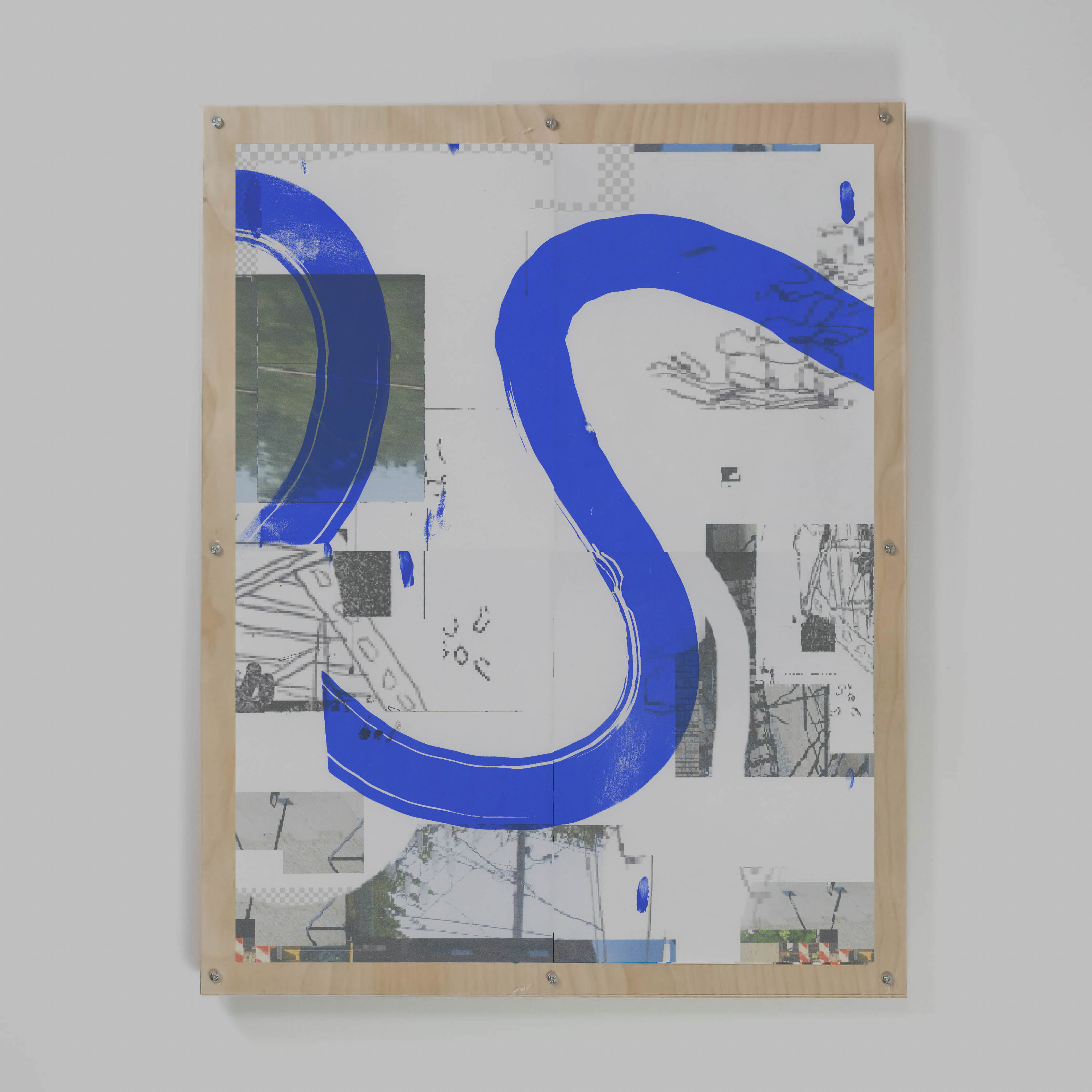
I look forward to seeing it!
Thanks!
I know you see your body of field recordings as a kind of “archive” into which you can dip into, and through which you can move freely. And this newsletter has a longstanding interest in archives and especially art made from archives — it began life as a deep dive into my personal collection of around 20,000 notecards. I want to ask something about how or whether your archive distinguishes between audio material and visual material.
But first — I notice that the field recordings on caught in pointers cover a specific time-span: 2014-2019. Do you still carry the field recorder with you everywhere, or is that a practice that you stopped at the end of that time span? If you’re still making them, what’s the significance of the 2019 cutoff? Is that just when you started working on this project?
Yea, I finished the record & shared it with the label at the end of 2019, so the cutoff was just that past present. Again, going back to that thought about self-centering… I don't want to share too much about that time but 2014 was (probably) the year that I first started making the field recordings and that period includes the early high-school through college part of my life, as I was quietly carrying a field recorder around & doing this strange thing that no one around me really understood. So it feels like a bit of a corny coming of age movie about my normal average life but with a bit of magical realism & time travel references mixed in.
And, yea, I'm still doing it. i'm possibly not doing it “for” music in quite the same way as it was before finishing this record — I'm still making music but there are other things I want to explore outside of personal archiving. so I'm doing it a little bit more for myself now & that feels nice. and i'm getting more comfortable with the idea of just listening & not recording anything, that feels nice too.
So with regard to the twinned archives — do you have a visual archive that mirrors the sonic one? Like one for photography and one for recordings? Or do you seem them all as part of a single big “life archive?” This is the part where I want to see how your documents folders are organized.
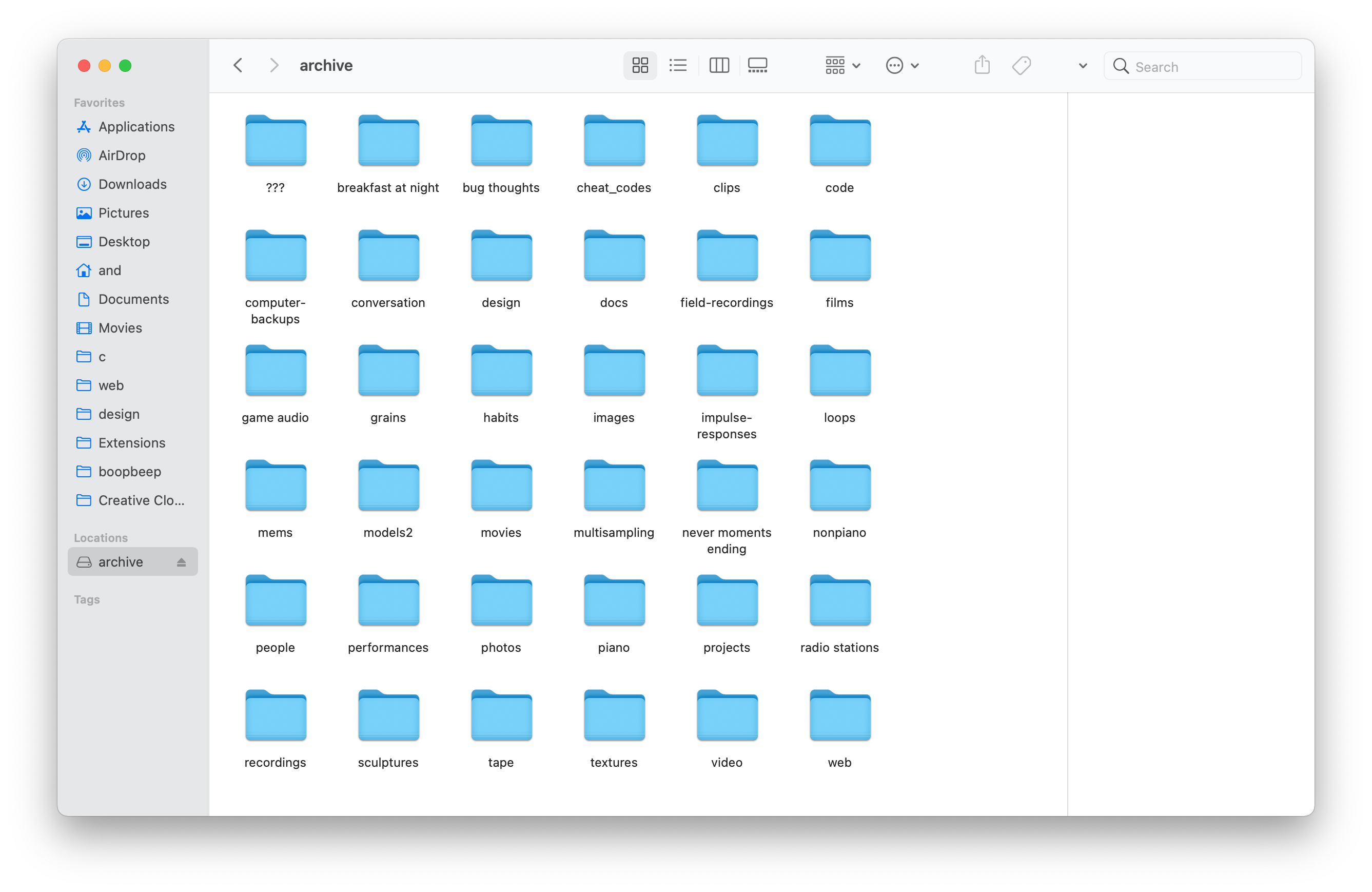
Hmm. A little messy, honestly.
"Bug thoughts" is good.
There are definitely some folders in there that I haven't touched in a while. Also painfully close to the 1TB limit on the hard drive.
The olds say that kids these days don't make file hierarchies. I'm glad to see that that's not totally true. Hierarchies aside, this looks like “one big archive.”
Haha, I guess so! One thing I will share: my field recordings (much larger than the photo archive) are all organized by year & season now. I went through different phases of how to organize it (like location rather than time) but that's what I landed on.
I want to return one last time to the notion of “home” in ambient or digital music4. When you envision an “ideal listener” for this—if you do—do you envision someone listening at home? Its delicacy and close-mic'd detail seems to qualify it as music that works best in a quiet environment: I don’t imagine that you picture people blasting it on a roadtrip, for instance, or at a club. Though maybe I have that wrong: I listened to caught in pointers on a plane trip this week and it worked great sort of drifting on top of a blanket of jet-engine noise.
Yea, it was all certainly made in my own home & I think that comfortable & quieter spaces allow for the smaller details to leak in a bit better. But the fun/scary thing about releasing music publicly is that it's not yours anymore & that it will possibly fit into other peoples lives in a way that is ultimately very personal for them in whatever places they find it in.
I don't really listen to it myself much anymore but a few months back I listened while walking/L-ing around Chicago & it was interesting to hear it talking with some of the real spaces that went into it (and that mastering by Matthewdavid really helps it shine in the louder zones).
You’ve also played a live show here and there. Any shows coming up to promote the new album?
Yes! On April 27th at Comfort Station in Chicago I'm doing a show with some good friends that inspired me while I was making the record.
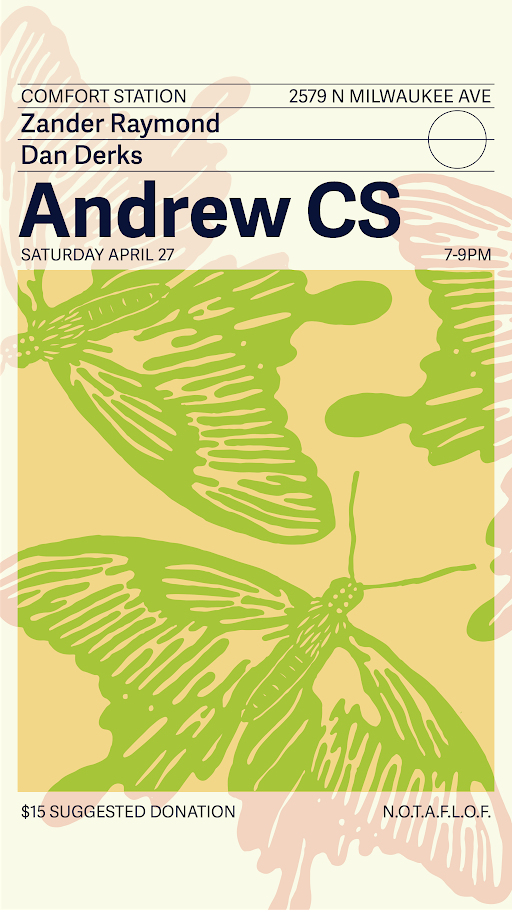
Oh great. Zander Raymond is on that bill? I was a big fan of last year's Parayellowgram!
He's a local legend. We also have a funny history of apparently looking identical, like getting mixed up at most events that feature one or both of us.
More science fiction conceits. Maybe you are from adjacent points in the same timeline, a la Primer.
I'd be honored to be clones.
I'll be in town then, and I will try to make it, though I might need to switch around some events on my calendar5. Anyway. Thank you for your time!
Thanks for including me!
Andrew CS’ albums are available through their Bandcamp page, or through the Bandcamp page of Leaving Records.
If you read this newsletter, and you live in Chicago, and you want to grab coffee or a drink, drop me a line. I’m hoping to expand my social circle there. ↩
It’s always interesting to see how labels or publishers that want to do intermedia work approach it. Cached has a section on their new site, intriguingly, for “agriculture.” ↩
Fuubutsushi has a double album coming out this summer, which looks like it’s going to be a banger. ↩
While prepping for this interview, I put on Darren Harper and Jared Smyth’s under-appreciated ambient masterpiece Home (2012), which might slot nicely next to any of Andrew’s albums. It features a similar mix of simple, warm instruments, digitally processed electronic sound, and field recordings, with a special emphasis on small, repetitive, quiet sounds, recorded with a close mic: sounds like small wooden thumps, crumpling paper, little shredding noises that sound like they might be someone peeling up tape. ↩
I had tickets for an April 27 screening of Vera Drew’s remarkable-looking The People’s Joker, which reimagines the origin story of DC’s Clown Prince of Crime as a trans coming-of-age story. Given the thorny legal concerns that loom intimidatingly over any unlicensed use of a character from a megacorporation’s IP stable, I felt certain that The People’s Joker would circulate only as samizdat. (It enjoyed one screening at the Toronto International Film Festival before the remaining screenings were pulled.) But it mounted a fair use defense and has managed to evade legal prosecution long enough to secure a full US tour this month. I’ve since acquired tickets for the April 26th show instead so I can do both [why_not_both.gif]. Tickets are non-refundable, though, so if you know any queers, weirdos, or comics fans who need tickets for the April 27th screening, I have an extra pair. ↩
![Wednesday Investigations [2:15]: Blind spots, part two](/content/images/size/w960/2025/05/jeph-jerman.jpg)
![Wednesday Investigations [2:14]: Blind spots](/content/images/size/w960/2025/05/takehisa-kosugi.jpg)